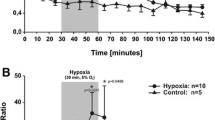Abstract
Microdialysis presents the unique possibility to measure metabolite concentrations in human interstitial fluid. During exercise, the recovery of these metabolites should be precisely monitored since it is known to increase greatly with muscle blood flow. The loss of ethanol, perfused at low concentration, can be accurately measured and reflects the changes in dialysis conditions. We evaluated whether using the relationship determined in resting metabolic conditions between the loss of ethanol, as reference substance, and the recovery for lactate or glucose would allow us to calculate precisely the concentration of these substances and their variations during exercise. Using the new catheter calibration method (slope method), the error of estimation of lactate and glucose in vitro was limited to −0.6 (5.8)% and −0.7 (6.2)%, respectively. In resting human muscle, the slope method proved to be as accurate as an established calibration technique (“no net flux method”) to evaluate interstitial lactate concentration [1.82 (0.58) vs 1.83 (0.47) mM, respectively]. During dynamic knee-extension exercise or light neuromuscular electrical stimulation, the estimated interstitial lactate and glucose concentrations varied differently, but their time course changes remained consistent with their respective plasma values. We conclude that, after an initial calibration step, the slope method allows accurate measurement of interstitial muscle metabolites and it could be used to monitor rapid metabolic changes during exercise.



Similar content being viewed by others
References
Andersen P, Adams RP, Sjogaard G, Thorboe A, Saltin B (1985) Dynamic knee extension as model for study of isolated exercising muscle in humans. J Appl Physiol 59:1647–1653
Arner P (1999) Microdialysis: use in human exercise studies. Proc Nutr Soc 58:913–917
Bolinder J, Ungerstedt U, Arner P (1992) Microdialysis measurement of the absolute glucose concentration in subcutaneous adipose tissue allowing glucose monitoring in diabetic patients. Diabetologia 35:1177–1180
Boschmann M, Rosenbaum M, Leibel RL, Segal KR (2002) Metabolic and hemodynamic responses to exercise in subcutaneous adipose tissue and skeletal muscle. Int J Sports Med 23 (8):537–543
De la Pena A, Liu P, Derendorf H (2000) Microdialysis in peripheral tissues. Adv Drug Deliv Rev 45:189–216
Hagstrom-Toft E, Enoksson S, Moberg E, Bolinder J, Arner P (1997) Absolute concentrations of glycerol and lactate in human skeletal muscle, adipose tissue, and blood. Am J Physiol 273:E584–E592
Henriksson J (1999) Microdialysis of skeletal muscle at rest. Proc Nutr Soc 58:919–923
Hickner RC, Rosdahl H, Borg I, Ungerstedt U, Jorfeldt L, Henriksson J (1992) The ethanol technique of monitoring local blood flow changes in rat skeletal muscle: implications for microdialysis. Acta Physiol Scand 146:87–97
Hickner RC, Bone D, Ungerstedt U, Jorfeldt L, Henriksson J (1994) Muscle blood flow during intermittent exercise: comparison of the microdialysis ethanol technique and 133Xe clearance. Clin Sci 86:15–25
Hickner RC, Fisher JS, Ehsani AA, Kohrt WM (1997) Role of nitric oxide in skeletal muscle blood flow at rest and during dynamic exercise in humans. Am J Physiol 273:H405–H410
Langberg H, Skovgaard D, Bulow J, Kjaer M (1999a) Negative interstitial pressure in the peritendinous region during exercise. J Appl Physiol 87:999–1002
Langberg H, Skovgaard D, Karamouzis M, Bulow J, Kjaer M (1999b) Metabolism and inflammatory mediators in the peritendinous space measured by microdialysis during intermittent isometric exercise in humans. J Physiol (Lond) 515:919–927
Langberg H, Skovgaard D, Petersen LJ, Bulow J, Kjaer M (1999c) Type I collagen synthesis and degradation in peritendinous tissue after exercise determined by microdialysis in humans (see comments). J Physiol (Lond) 521:299–306
Lönnroth P, Jansson PA, Fredholm BB, Smith U (1989) Microdialysis of intercellular adenosine concentration in subcutaneous tissue in humans. Am J Physiol 256:E250–E255
MacLean DA, Bangsbo J, Saltin B (1999) Muscle interstitial glucose and lactate levels during dynamic exercise in humans determined by microdialysis. J Appl Physiol 87:1483–1490
MacLean DA, Imadojemu VA, Sinoway LI (2000) Interstitial pH, K(+), lactate, and phosphate determined with MSNA during exercise in humans. Am J Physiol 278:R563–R571
Radegran G, Pilegaard H, Nielsen JJ, Bangsbo J (1998) Microdialysis ethanol removal reflects probe recovery rather than local blood flow in skeletal muscle. J Appl Physiol 85:751–757
Rosdahl H, Lind L, Millgard J, Lithell H, Ungerstedt U, Henriksson J (1998) Effect of physiological hyperinsulinemia on blood flow and interstitial glucose concentration in human skeletal muscle and adipose tissue studied by microdialysis. Diabetes 47:1296–1301
Sjöstrand M, Holmang A, Lonnroth P (1999) Measurement of interstitial insulin in human muscle. Am J Physiol 276:E151–E154
Sjöstrand M, Holmang A, Strindberg L, Lonnroth P (2000) Estimations of muscle interstitial insulin, glucose, and lactate in type 2 diabetic subjects. Am J Physiol 279:E1097–E1103
Stallknecht B, Donsmark M, Enevoldsen LH, Fluckey JD, Galbo H (1999) Estimation of rat muscle blood flow by microdialysis probes perfused with ethanol, [14C]ethanol, and 3H2O. J Appl Physiol 86:1054–1061
Strindberg L, Lonnroth P (2000) Validation of an endogenous reference technique for the calibration of microdialysis catheters. Scand J Clin Lab Invest 60:205–211
Acknowledgements
The authors address their special thanks to Dr. C. Perier and Mr. R. Bonnefoy for their advice and technical help. We are also undebted to Dr. J. Toulon for providing the artificial dialysis kidney. This study was supported by a grant from Région Rhône-Alpes, “Programme Emergence 2000”. N. Desvigne was a recipient of a thesis grant from Région Rhône-Alpes.
Author information
Authors and Affiliations
Corresponding author
Rights and permissions
About this article
Cite this article
Desvigne, N., Barthélémy, J.C., Bertholon, F. et al. Validation of a new calibration method for human muscle microdialysis at rest and during exercise. Eur J Appl Physiol 92, 312–320 (2004). https://doi.org/10.1007/s00421-004-1099-0
Accepted:
Published:
Issue Date:
DOI: https://doi.org/10.1007/s00421-004-1099-0




